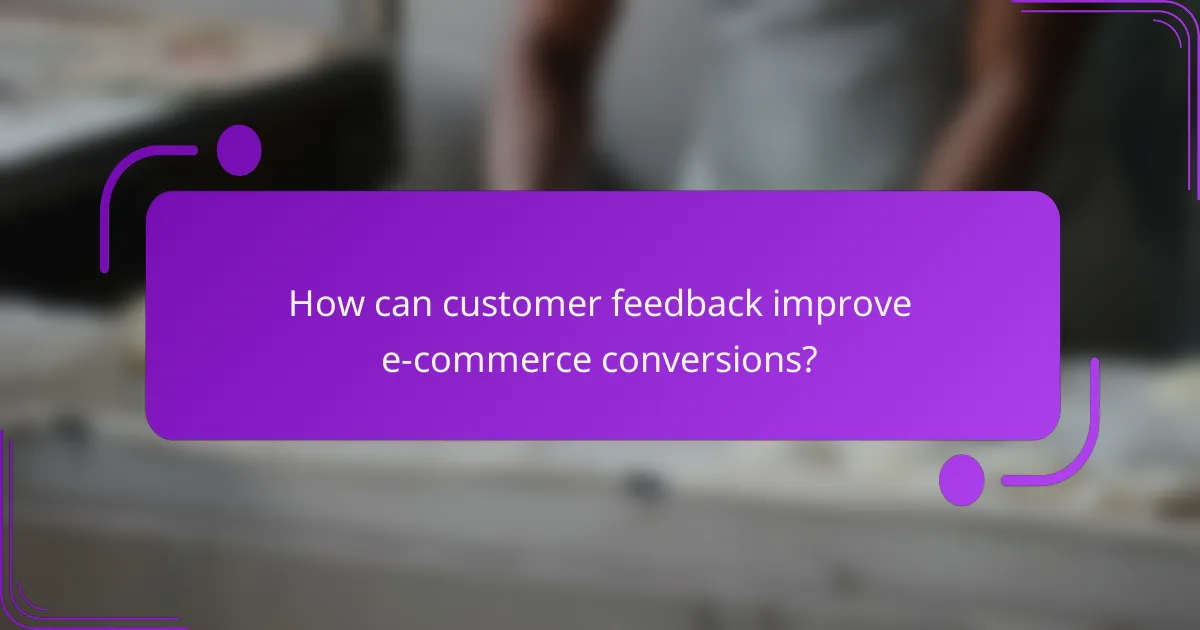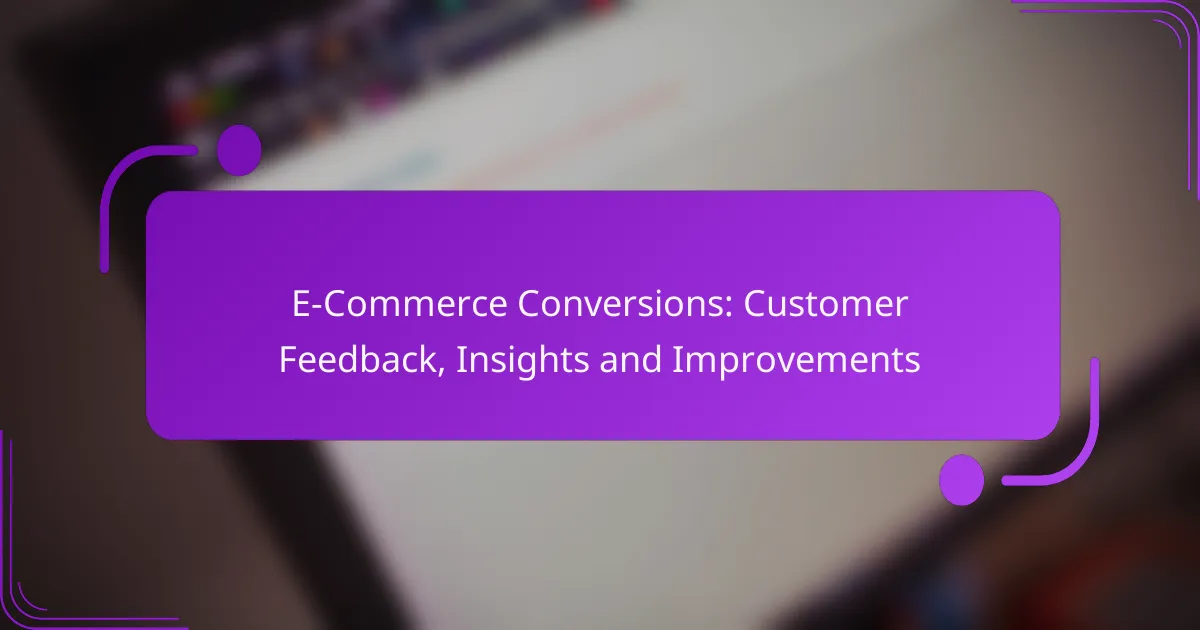In the competitive landscape of e-commerce, customer feedback plays a crucial role in driving conversions by revealing consumer preferences and addressing pain points. By leveraging various feedback collection tools and analyzing insights effectively, businesses can enhance their offerings and improve customer satisfaction, ultimately leading to higher conversion rates.

How can customer feedback improve e-commerce conversions?
Customer feedback is essential for enhancing e-commerce conversions as it provides insights into consumer preferences and pain points. By actively collecting and analyzing this feedback, businesses can make informed decisions that lead to better products and services, ultimately increasing conversion rates.
Increased customer satisfaction
Gathering customer feedback allows e-commerce businesses to understand what their customers value most. By addressing concerns and implementing suggestions, companies can create a more satisfying shopping experience. For instance, if customers frequently mention slow shipping times, improving logistics can significantly enhance satisfaction levels.
Regularly engaging with customers through surveys or reviews can help identify areas for improvement, ensuring that their needs are met consistently.
Enhanced product offerings
Customer feedback provides direct insights into product performance and preferences, enabling businesses to refine their offerings. By analyzing feedback, companies can identify which products resonate with consumers and which do not. This can lead to the development of new products that better meet market demands.
For example, if a product receives consistent feedback about a specific feature being lacking, businesses can prioritize enhancements or introduce new variations to cater to customer desires.
Improved user experience
Utilizing customer feedback can significantly enhance the overall user experience on e-commerce platforms. Insights into navigation difficulties, checkout processes, or website speed can guide necessary adjustments. Streamlining these elements based on user input can reduce friction during the purchasing process.
Implementing changes such as simplified checkout forms or improved site navigation can lead to higher conversion rates as customers find it easier to complete their purchases.
Higher retention rates
When customers feel heard and valued, they are more likely to return for future purchases. By acting on feedback, businesses can foster loyalty and build long-lasting relationships. Regular follow-ups and updates on how feedback has been implemented can further enhance this connection.
Offering loyalty programs or personalized experiences based on feedback can also encourage repeat business, contributing to higher retention rates.
Boosted sales
Ultimately, leveraging customer feedback can lead to increased sales. By improving product offerings, enhancing user experience, and ensuring customer satisfaction, businesses create an environment conducive to higher conversion rates. Satisfied customers are more likely to make repeat purchases and recommend the brand to others.
Additionally, targeted marketing strategies informed by customer insights can attract new customers and drive sales growth. For instance, highlighting popular products based on feedback in promotional campaigns can effectively capture interest and boost revenue.

What tools can be used for collecting customer feedback?
Various tools are available for collecting customer feedback, each offering unique features to help businesses understand their customers better. Selecting the right tool depends on your specific needs, such as the type of feedback desired and the methods of collection.
SurveyMonkey for surveys
SurveyMonkey is a popular platform for creating and distributing surveys. It allows businesses to design custom questionnaires to gather insights on customer satisfaction, product feedback, and more. With various templates and question types, you can tailor surveys to fit your brand’s voice.
Consider using SurveyMonkey’s analytics tools to interpret results effectively. This can help identify trends and areas for improvement. Be mindful of survey length; keeping it concise can lead to higher response rates.
Hotjar for user behavior tracking
Hotjar provides insights into user behavior through heatmaps, session recordings, and feedback polls. This tool helps you understand how customers interact with your website, allowing you to identify pain points and optimize the user experience.
Utilizing Hotjar’s features can reveal where users click, scroll, or abandon their carts. This data is crucial for making informed design decisions. Ensure you respect user privacy and comply with regulations such as GDPR when tracking behavior.
Google Forms for feedback collection
Google Forms is a free and user-friendly tool for collecting feedback. It enables businesses to create surveys and questionnaires that can be easily shared via links or embedded on websites. The simplicity of Google Forms makes it accessible for users of all skill levels.
Responses are automatically collected in Google Sheets, allowing for easy analysis. While it lacks some advanced features of dedicated survey tools, it is ideal for quick feedback collection without any cost. Keep your forms straightforward to encourage participation.
Trustpilot for reviews
Trustpilot is a well-known platform for collecting and displaying customer reviews. Businesses can invite customers to leave feedback on their experiences, which can enhance credibility and attract new customers. Positive reviews can significantly influence purchasing decisions.
Encouraging customers to leave reviews on Trustpilot can help build your online reputation. However, be aware of the importance of responding to both positive and negative reviews to demonstrate customer care. Regularly monitoring your Trustpilot profile can provide valuable insights into customer perceptions.

What are the best practices for analyzing customer insights?
To effectively analyze customer insights, focus on gathering and interpreting data that reflects customer behavior and preferences. Best practices include segmenting customer data, utilizing sentiment analysis tools, and implementing A/B testing to refine strategies.
Segmenting customer data
Segmenting customer data involves dividing your customer base into distinct groups based on shared characteristics such as demographics, purchasing behavior, or preferences. This allows for tailored marketing strategies that resonate more effectively with each segment.
Consider using criteria like age, location, or purchase history to create segments. For example, a clothing retailer might segment customers into categories like “young adults” and “families,” enabling targeted promotions that appeal to each group’s specific needs.
Using sentiment analysis tools
Sentiment analysis tools help businesses gauge customer feelings towards products or services by analyzing feedback from reviews, social media, and surveys. These insights can reveal how customers perceive your brand and identify areas for improvement.
Utilize tools like Google Cloud Natural Language or IBM Watson to process large volumes of text data. For instance, if a significant number of reviews mention dissatisfaction with shipping speed, this insight can prompt you to evaluate and enhance your logistics processes.
Implementing A/B testing
A/B testing involves comparing two versions of a webpage or marketing material to determine which performs better in terms of conversion rates. This method allows you to make data-driven decisions based on actual customer responses.
For effective A/B testing, change only one variable at a time, such as the call-to-action button color or the layout of a product page. Run tests for a sufficient duration to gather reliable data, typically a few weeks, depending on your traffic volume. This approach minimizes risks and maximizes the potential for improved conversions.

How can e-commerce platforms implement feedback loops?
E-commerce platforms can implement feedback loops by actively seeking customer input and integrating that feedback into their operations. This process helps identify areas for improvement and enhances the overall shopping experience.
Regular customer surveys
Conducting regular customer surveys is essential for gathering actionable insights. These surveys can be distributed via email, on-site pop-ups, or social media, and should focus on customer satisfaction, product quality, and service efficiency.
To maximize response rates, keep surveys concise and offer incentives, such as discounts or loyalty points. Aim for a response rate of at least 10-20% to ensure the data is representative of your customer base.
Incorporating feedback into product development
Incorporating customer feedback into product development allows e-commerce platforms to align their offerings with market demands. Analyze survey results and reviews to identify common pain points or desired features, then prioritize these insights in your product roadmap.
Consider using agile methodologies to iterate on product designs quickly. For instance, if customers express a need for more size options, implement these changes in the next production cycle to meet demand promptly.
Establishing a review system
Establishing a robust review system encourages customers to share their experiences and helps build trust with potential buyers. Ensure that the review process is straightforward, allowing customers to leave feedback easily after purchase.
Display reviews prominently on product pages and respond to both positive and negative feedback. This engagement shows customers that their opinions matter and can significantly enhance brand loyalty.

What are the key metrics to track for conversion improvements?
Key metrics for tracking conversion improvements include conversion rate, average order value, and cart abandonment rate. Monitoring these metrics helps identify areas for enhancement and informs strategies to boost sales.
Conversion Rate
The conversion rate measures the percentage of visitors who complete a desired action, such as making a purchase. To calculate it, divide the number of conversions by the total number of visitors and multiply by 100. A typical conversion rate for e-commerce sites ranges from 1% to 3%, but optimizing your site can push this higher.
Improving the conversion rate often involves enhancing user experience, such as simplifying the checkout process or improving product descriptions. Regular A/B testing can help identify which changes lead to higher conversions.
Average Order Value
Average order value (AOV) indicates the average amount spent each time a customer places an order. To calculate AOV, divide total revenue by the number of orders. AOV can vary significantly by industry, but increasing it is crucial for boosting overall revenue.
Strategies to increase AOV include offering bundled products, upselling, or providing discounts for larger purchases. For example, a clothing retailer might offer a discount on a second item to encourage customers to buy more.
Cart Abandonment Rate
The cart abandonment rate reflects the percentage of shoppers who add items to their cart but do not complete the purchase. A high abandonment rate, often around 60-80%, can indicate issues in the checkout process or unexpected costs, such as shipping fees.
To reduce cart abandonment, consider simplifying the checkout process, offering guest checkout options, and being transparent about shipping costs early in the process. Sending follow-up emails to remind customers of their abandoned carts can also help recover lost sales.
